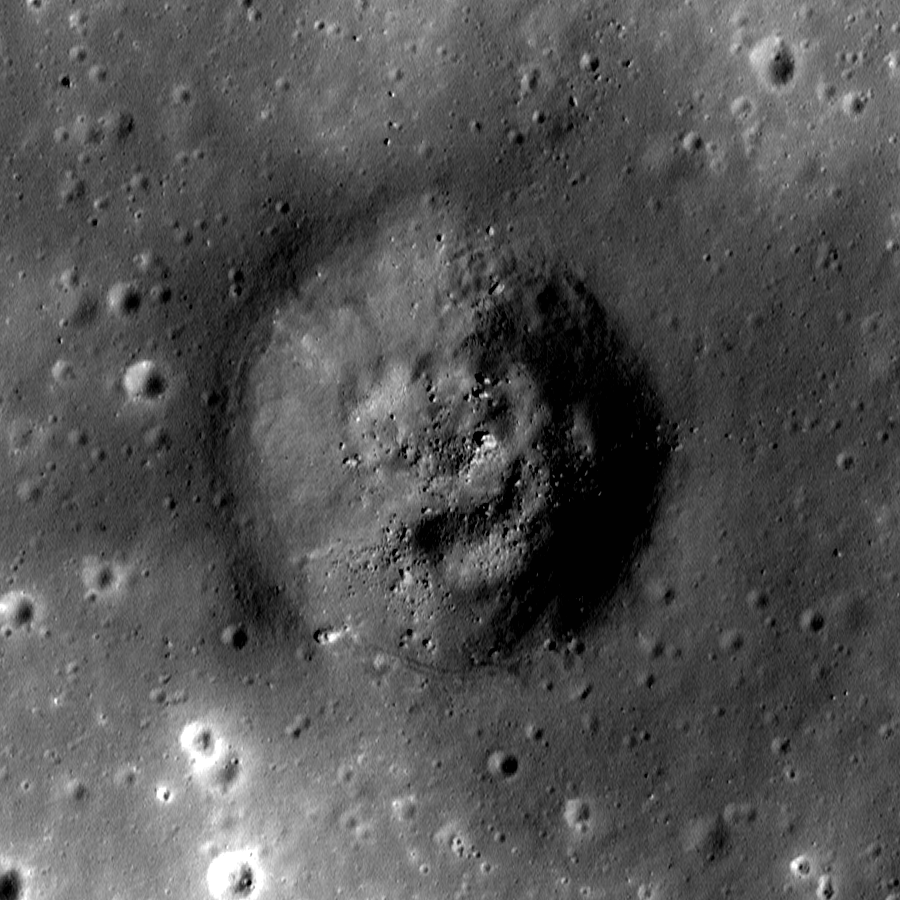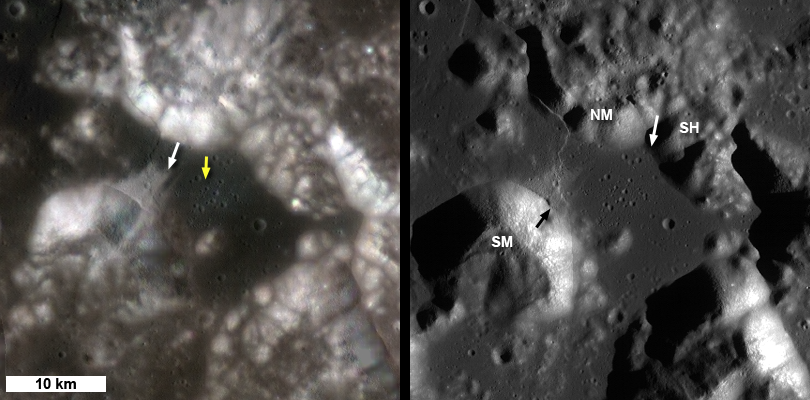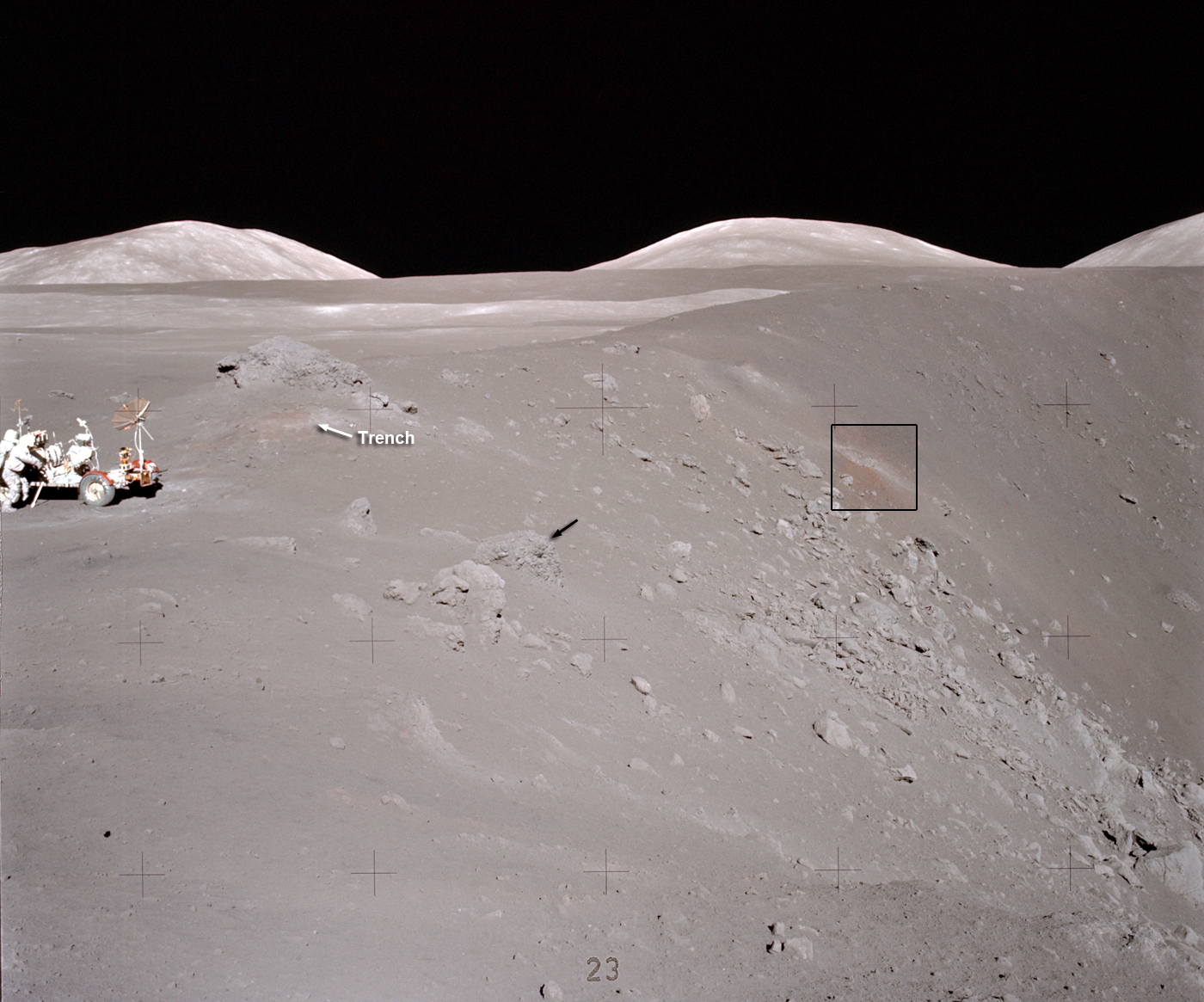
Shorty crater is an amazing place on the Moon! From relatively low resolution Apollo 15 orbital photos, Apollo-era scientists identified this small crater as a place worth visiting. Even though the existing images at the time had limited resolution, analysts could see that Shorty crater was surrounded by a dark (low reflectance) field of ejecta. Since the surrounding areas seemed to be blanketed by pyroclastic (explosive volcanism) materials, the dark ejecta around Shorty crater led scientists to speculate that perhaps this crater was a volcanic vent, and not an impact scar (see the pre-mission USGS geologic map of Taurus-Littrow) even though impact remained the preferred interpretation. It was yet another reason to send an Apollo lander to the valley of Taurus-Littrow.
On 11 December 1972, Apollo 17 landed in the middle of this fascinating valley. The mission goals included sampling rocks and soil that might reveal the age of the distant Tycho crater forming impact, sampling ancient highland material that might reveal the ages of two mighty basins, return another variety of basalt, collect dark pyroclastic material, and see if Shorty crater was indeed a volcanic vent. Shorty crater is found (white arrow, left WAC mosaic) on a tongue of high reflectance material emanating from South Massif (labeled 'SM' on right right mosaic), about 7 km to the west of the Apollo 17 landing site (yellow arrow).
Apollo 17 astronauts Harrison "Jack" Schmitt and Eugene "Gene" Cernan spent three days performing a reconnaissance exploration of part of Taurus-Littrow Valley. On the second day they drove the Lunar Roving Vehicle (LRV) as far as 8.7 km WSW of the Lunar Module (LM), to the edge of Nansen crater, at the foot of South Massif. On the way back to the LM they headed north across Lee Lincoln scarp (a thrust fault), and on to Shorty crater. It was at the edge of Shorty crater where Schmitt first noticed orange soil underfoot! At the moment it seemed that the crew had indeed discovered oxidized rock, a sure sign of fumarolic volcanic vent.
Harrison Schmitt, a life-long geologist, is still very active in the planetary science community and wrote a few thoughts upon seeing the new NAC image of Shorty crater.
"The image shows the location of the one-wall trench I dug across the crater rim to get samples of the orange glass and the black partially crystallized glass beneath it. I dug the trench wall so it faced the sun to provide good photographic images. Using the sampling scoop I normally carried, I threw the trench debris so that it all went away from the boulder. Being orange rather than gray, the debris is slightly lighter than the surrounding surface debris (regolith), and is visible as a spray pattern in the image."
"Shorty Crater is about 14 m deep. Based on our investigations at the site and later examination of photographs, the impact that formed it penetrated, in order, regolith on the avalanche deposit, the avalanche deposit, regolith on a basalt flow, a basalt flow overlying and protecting the orange and black glass layers, the orange and black glass layers, regolith on a second basalt flow, and, finally, the upper portion of that second flow. Orange and black glass clods and basalt boulders are spread throughout the ejecta blanket surrounding Shorty." Harrison H. Schmitt, Lunar Module Pilot and Geologist, Apollo 17
You can see the orange soil that Schmitt sampled in the surface photo shown above, note also the streamer of orange glass extending down the the steep inner wall of the crater (indicated with black box). To help orient yourself in the surface image, imagine yourself standing on the spot marked 'Color Pan' in the NAC image, that is the viewpoint from where Gene captured his 360° panorama series of photographs. If you look closely in the NAC image, you can trace Cernan's tracks from the area of the trench that Schmitt dug, and then back to the rover (two darker parallel lines).
As it turns out the orange soil was not oxidized vent material, but something equally exciting -- titanium-rich pyroclastic glass! When the Shorty impact event occurred, the pyroclastic glass was excavated from about 10 meters below the surface and thrown out onto the rim. Talk about a case of lucky timing! The orange glass was deposited several billion years ago, then shortly after it was deposited, a thin layer of basalt flooded this portion of the valley and formed a protective cap. Then, not too long ago, the orange glass was brought to the surface and the Apollo 17 crew arrived. Eventually the Shorty crater deposits will get churned back into the surrounding landscape by small impacts: Schmitt and Cernan came by at just the right geologic time.
What did we learn from the orange and black soil? These key samples showed that the idea that the valley had witnessed very large fire fountaining eruptions was correct. Imagine lava being erupted so fast that it shot up many hundreds of meters, and splashed over the terrain for many tens of kilometers. Why so high? Because there were large amounts of gases in the magma that rapidly exsolved as it neared the surface. A process similar to what you experience upon shaking a soda can and opening it up -- spray! Scientists were able to find minute remnants of volatiles on the glass beads (both orange and black), including zinc and sulfur. From the extent of the deposit and its composition, it was clear that these materials came from deep sources within the Moon's mantle. So by simply walking to the edge of this small, seemingly insignificant, crater the crew were able to sample and bring back incredibly valuable samples of the deep Moon.
That is not the end of the story, the next day Cernan and Schmitt drove north and then east to sample the North massif (NM) and the Sculptured hills (SH). Both destinations were older than the mare, they represented two different ancient crustal samples. From these rocks scientists were able to determine absolute age dates for the formation of an ancient basin. All-in-all Apollo 17 was a smashing success for both science and engineering.
Read more about the geology of Taurus-Littrow valley in the definitive USGS report and in Schmitt's 1973 paper in Science, and examine Shorty crater and its environs in detail.
Thirty-nine years have passed since humans last walked on the Moon. When will we return?
Published by Mark Robinson on 12 December 2011


